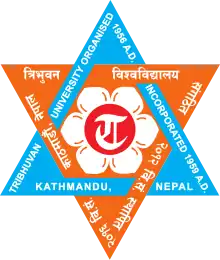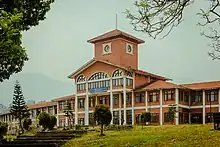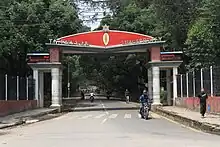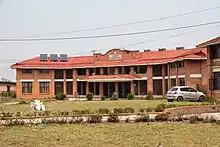Tribhuvan University
Tribhuvan University (TU; Nepali: त्रिभुवन विश्वविद्यालय, romanized: त्रिभुवन विश्वविद्यालय) is a public university located in Kirtipur, Kathmandu, Nepal. Established in 1959, TU is the oldest and the largest university in Nepal. The college offers 1000 undergraduate and 500 postgraduate programs across a wide range of disciplines.[4] Additionally, the institution has 62 constituent campuses and over 1080 affiliated colleges across the country.[5]
त्रिभुवन विश्वविद्यालय | |
 Logo of Tribhuvan University (blue and red hexagram) | |
| Type | Public |
|---|---|
| Established | 25 June 1959 |
| Budget | Rs. 15 billion (USD $130 million) (2019–20) |
| Chancellor | Prime Minister of Nepal |
| Vice-Chancellor | Dr. Dharma Kanta Baskota |
| Rector | Dr. Shivalal Bhusal[1] |
Academic staff | 7,049 professorial faculty 5607 other faculty[2] |
| Students | 604,437[3] |
| Location | , 27.68184°N 85.28646°E |
| Campus | Kirtipur |
| FSU chairman | Shyam Raj Ojha (NSU) |
| Website | tribhuvan-university.edu.np tu.edu.np |
History
Established on 25 June 1959 (or 12 Ashar 2016 BS),[6] Tribhuvan University is the oldest and largest university in Nepal. The university was named after the late King Tribhuvan. In its early years, all the postgraduate classes were held at Tripureshwor Campus. The administrative office was also located in Tripureshwor. It was only in 1967 that the university was relocated to its main campus in Kirtipur – an ancient town about 5 km south-west of the city of Kathmandu. The university, which spreads over an area of 154.77 hectares, constitutes the Central Administrative Office and the Central Campus.[7]
Academics


Since its inception, the state-owned university has expanded its programmes. There are five technical institutes and four general faculties. The university offers 115 courses for the technical proficiency certificate level. TU offers 1079 courses at Bachelor's level and 1000 courses at Master's level. It offers PhD degrees in the technical institutes and faculties.
Tribhuvan University ran its programmes only through its constituent campuses before 1980. With the increasing number of students seeking higher education, it was not possible to accommodate all the students in the constituent campuses. This situation led to the establishment of colleges in the private sector because the constituent campuses alone could not meet the demand. From 1979 to 1980, TU started providing affiliation to private colleges. As of April 2016, 1,084 private and public colleges were affiliated with TU.[8]
In the 2014–2015 academic session 405,341 students were enrolled in TU academic programmes. 148,141 (36.55%) students study in its 60 constituent campuses including 38 central departments, while 257,200 (63.45%) students study in 1,053 affiliated colleges.[9]
TU has 7,841 teaching faculty and 7,413 non-teaching staff including the support staff in its constituent campuses. The number of total employees is 15,254.[10]
Rankings
Tribhuvan University is ranked in the top 1201-1500 universities in the world as per the Times Higher Education World University Rankings in 2024, published by the Times Higher Education (THE) magazine. It is ranked among the 251-300 best universities of Asia.[11] It is ranked at 6676 in the world and 2nd in the country as per the 4icu Organisation of University Ranking.[12]
Technical institutes
The university administers its science and technology programs, such as BSc, BE, MBBS, etc., through its technical institutes. There are five technical institutes at the university, each taking care of a specific domain within the field of science and technology education.
Faculties and associated Central Departments
There are four faculties and a total of 40 associated central departments at the university:[13]

Constituent Campuses
TU has 62 constituent campuses. The following is a partial list of constituent colleges of the university:[14][15]
Koshi Province (12)
- Mahendra Ratna Multiple Campus, Illam
- Gaurahadaha Agriculture Campus, Jhapa
- Mechi Multiple Campus, Jhapa
- Mahendra Morang Adarsh Multiple Campus, Biratnagar
- Snatakottar Campus(Postgraduate Campus), Biratnagar
- Nursing Campus, Biratnagar
- Purwanchal Campus, Dharan
- Mahendra Multiple Campus, Dharan
- Central Campus of Technology, Dharan
- Dhankuta Multiple Campus, Dhankuta
- Tehrathum Multiple Campus, Terhathum
- Bhojpur Multiple Campus, Bhojpur
Madhesh Province (5)
- Ramshwaroop Ramsagar Multiple Campus, Janakpur
- Thakur Ram Multiple Campus, Birgunj
- Birgunj Nursing Campus, Birgunj
- Surya Narayana Satya Narayana Morveta Yadhav Multiple Campus, Siraha
- Mahendra Bindeshwori Multiple Campus, Saptari
Outside Kathmadu Valley (4)
Kathmandu Valley (22)
- Sanothimi Campus, Bhaktapur
- Bhaktapur Multiple Campus, Bhaktapur
- Patan Samyukta Campus, Patandhoka
- Pulchowk Campus, Pulchowk
- Nepal Commerce Campus, Min Bhawan
- Thapathali Campus, Thapathali
- Jana Prasashan Campus, Balkhu
- University Campus, Kirtipur
- Mahendra Ratna Campus, Tahachal
- Ayurved Campus, Kirtipur
- Public Youth Campus, Dhobichaur
- Saraswoti Multiple Campus, Lainchaur
- Amrit Campus, Lainchaur
- Central Medicine Campus, Maharajgung
- Nursing Campus, Maharajgunj
- Lalitkala Campus, Bhotahiti
- Trichandra Multiple Campus, Ghantaghar
- Padmakanya Multiple Campus, Bagbazar
- Shanker Dev Campus, Putalisadak
- Ratna Rajya Lakshmi Campus, Pradarshani Marg, Kathmandu
- Nepal Law Campus, Pradarshani Marg
- Bishwa Bhasa Campus, Pradarshani Marg
Gandaki Province (7)
- Paschimanchal Campus, Pokhara
- Gorkha Campus, Gorkha
- Lamjung Agriculture Campus, Sundarbazar
- Dhaulagiri Campus, Baglung
- Pokhara Nursing Campus, Pokhara
- Pokhara Forestry Campus, Pokhara
- Prithivi Narayan Campus, Pokhara
- Tribhuwan Multiple Campus, Syangja
Lumbini Province (6)
- Tribhuvan Multiple Campus, Palpa
- Butwal Multiple Campus, Butwal
- Paklihawa Agriculture Campus, Paklihawa
- Bhairahawa Multiple Campus, Bhairahawa
- Mahendra Multiple Campus, Dang
- Mahendra Multiple Campus, Nepalgunj
Karnali Province (3)
- Surkhet Multiple Campus, Birendranagar
- Jumla Multiple Campus, Jumla
- Musikot Multiple Campus, Rukum
Sudurpaschim Province (3)
- Doti Multiple Campus, Doti
- Dadeldhura Campus, Dadeldhura
- Siddhanath Science Campus, Mahendranagar
Organization
TU is government financed but still an autonomous organization.[2] The head of the government, the prime minister, is its chancellor.[16]
- Chancellor: Prime Minister of Nepal (Puspa Kamal Dahal 'Prachanda")
- Pro-Chancellor: Minister of Education (Shishir Khanal)
- Vice Chancellor: Prof. Dr. Dharma Kant Baskota
- Rector: Prof. Dr. Shiva Lal Bhusal
- Registrar: Prof. Dr. Peshal Dahal
Societies
- Nepal Chemical Society
- Nepal Mathematical Society
- Nepal Physical Society
Research centers
Tribhuvan University has the following research centers:[17]
- Centre for Economic Development and Administration (CEDA)
- Centre for Nepal and Asian Studies (CNAS), formerly called the Institute for Nepal and Asian Studies (INAS)
- Research Centre for Applied Science and Technology (RECAST)
- Research Centre for Educational Innovation and Development (CERID)
Departments
Notable alumni
- Pushpa Kamal Dahal - Prime Minister of Nepal
- Bimalendra Nidhi - Deputy Prime Minister of Nepal
- Arjun Narasingha KC - 5-time former Minister and Nepali Congress party leader completed his master's degree in political science at TU
- Gagan Thapa - former Health minister and popular Youth Leader who studied Sociology at TU
- Sushma Shakya - award-winning visual artist
- Sharada Sharma - writer
- Udayraj Khanal - scientist (Physics)
- Binil Aryal - scientist (Physics)
- Udit Narayan - playback singer
- Ujawal Jha - Social worker
References
- "About Tribhuvan University".
- "Tribhuvan University". Tribhuvan University. 6 October 2007. Archived from the original on 6 October 2007. Retrieved 30 March 2019.
- "Tribhuvan university".
- "UGC".
- Ghimire, Binod (25 September 2020). "Tribhuvan University to hold exams after festivals". The Kathmandu Post. Retrieved 25 September 2020.
The country's largest university has 61 constituent and over 1,100 private and community affiliated colleges.
- K.C., Tanka (2009). प्रज्ञान प्रतियोगितात्मक सामान्यज्ञान [Pragyan Competitive General Knowledge] (in Nepali). Kathmandu, Nepal: Pragyan Prakashan. p. 77.
- "About Us". tribhuvan-university.edu.np. Tribhuvan University. Retrieved 6 October 2016.
- "Over 1,000 colleges only temporarily affiliated to Tribhuvan University - The Himalayan Times". The Himalayan Times. 9 April 2016. Retrieved 24 January 2017.
- "About Us - Tribhuvan University of Nepal". tribhuvan-university.edu.np. Retrieved 25 May 2015.
- "about us".
- "Tribhuvan University". Times Higher Education (THE). 10 April 2019. Retrieved 17 May 2019.
- "Tribhuvan University World Ranking 2020". 4icu.org. 2005-2020 uniRank ™. Retrieved 8 March 2020.
- "Tribhuvan University of Nepal - Central Departments". Tribhuvan University. Retrieved 24 June 2021.
- "List of Constituent Campuses of Tribhuvan University". Tribhuvan University's Official Website. TU. Retrieved 31 May 2016.
- "Tribhuvan University of Nepal". tribhuvan-university.edu.np. Retrieved 29 April 2023.
- "PM Dahal stresses need of reforming TU". Retrieved 24 January 2017.
- "TU Research Centres". tribhuvan-university.edu.np. Retrieved 20 October 2018.
- "Central Department of Chemistry | Tribhuvan University".
- "Department of Mathematics: Tribhuvan University". Central Department of Mathematics TU. Retrieved 12 June 2015.
- "Home". Central Department of Public Administration. Retrieved 9 September 2013.